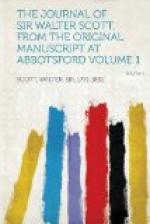[274] See Quart. Rev., Nov. 1829, or Misc. Prose Works, xxi. 152-198.
[275] George Dempster of Skibo, one of the few men connecting Scott with this generation, died in Edinburgh on the 6th of February 1889. This accomplished Scottish gentleman had for many years made his home at Ormiston, where, in the old mansion-house, rich in associations of Knox, Wishart, and Buchanan, he was the gracious host to a large circle of friends.
[276] Pope’s Moral Essays, iii.
[277] Ante, vol. i. p. 312, n.
[278] Mr. Lockhart says, writing in 1839:—“This head may still be seen over a laboratory at No. 100 South Bridge, Edinburgh. [It has since been removed.] N.B. There is a tradition that the venerable bust in question was once dislodged by ‘Colonel Grogg’ and some of his companions, and waggishly placed in a very inappropriate position.”
[279] Fenimore Cooper told Scott that the Princess had had Sir Walter’s portrait engraved in 1827 from the picture taken in Paris. [Mme. Mirbel’s miniature?]
[280] See Sheridan’s Critic.
[281] Lord Corehouse’s brother.
[282] Room may be made for part of one of the letters received by this morning’s mail, in which, after much interesting family detail, his son-in-law describes the duel which took place between the Duke of Wellington and Lord Winchelsea:—“There is no reason to expect a duel every day, and all has been very quiet since Saturday.—The letter was utterly forgotten till this recalled it to remembrance. Ergo, there was no sort of call on the Duke after beating Buonaparte to go to war with a booby. But he could not stand the fling at the fair. His correspondence seems admirable every way, and the whole affair was gone through in excellent taste,—the Duke and Hardinge trotting out, the two peaceful lords rumbling down in a coach and four. The Duke had no half-pence and was followed and bothered for some time by the tollman on Battersea Bridge, when Hardinge fished out some silver or a groom came up. There were various market gardeners on the road, who, when Lord Winchelsea’s equipage stopped, stopped also and looked on. One of them advised a turn up with nature’s weapons. The moment all was done the Duke clapped spars to his horse and was back in Downing Street within the two hours, breakfasted, and off to Windsor, where he transacted business for an hour or so, and then said, ’By-the-by, I was forgetting I have had a field-day with Lord W. this morning.’ They say the King rowed Arthur much for exposing himself at such a crisis.”
[283] Art of Preserving Health, book ii.
[284] George Ramsay, Earl of Dalhousie, had just been appointed Commander-in-Chief in the East Indies; which office he held till 1832. He died in 1838.
[285] Merchant of Venice, Act I. Sc. 1.




